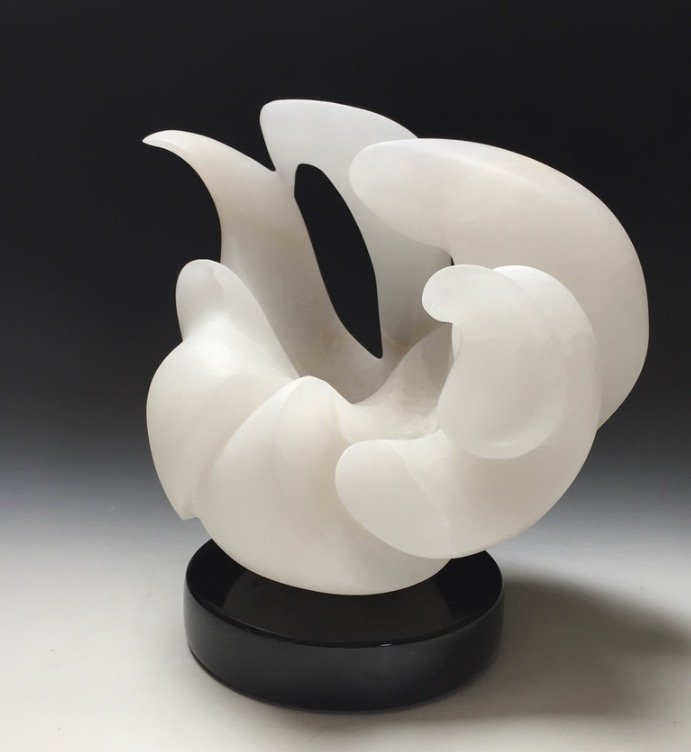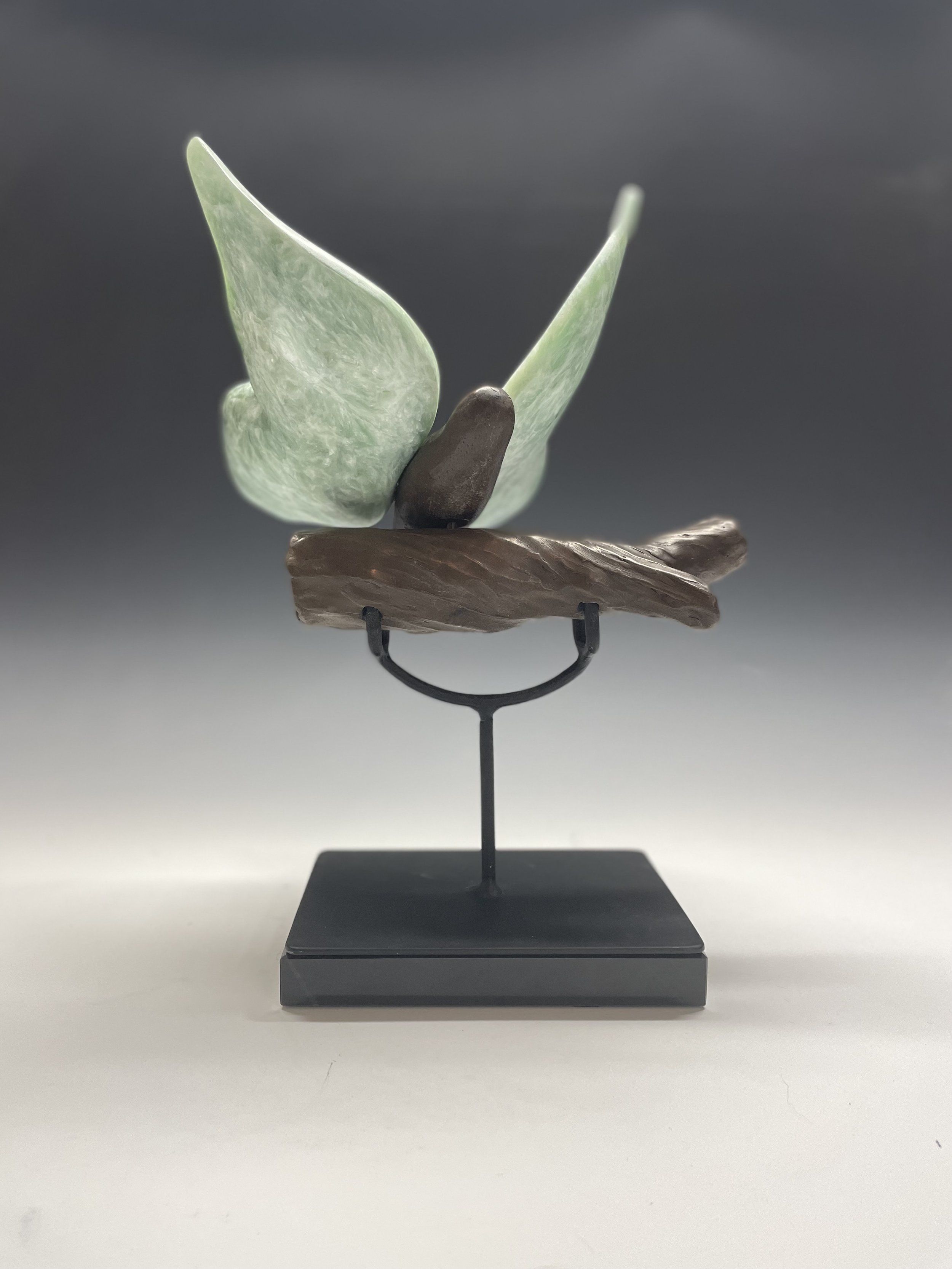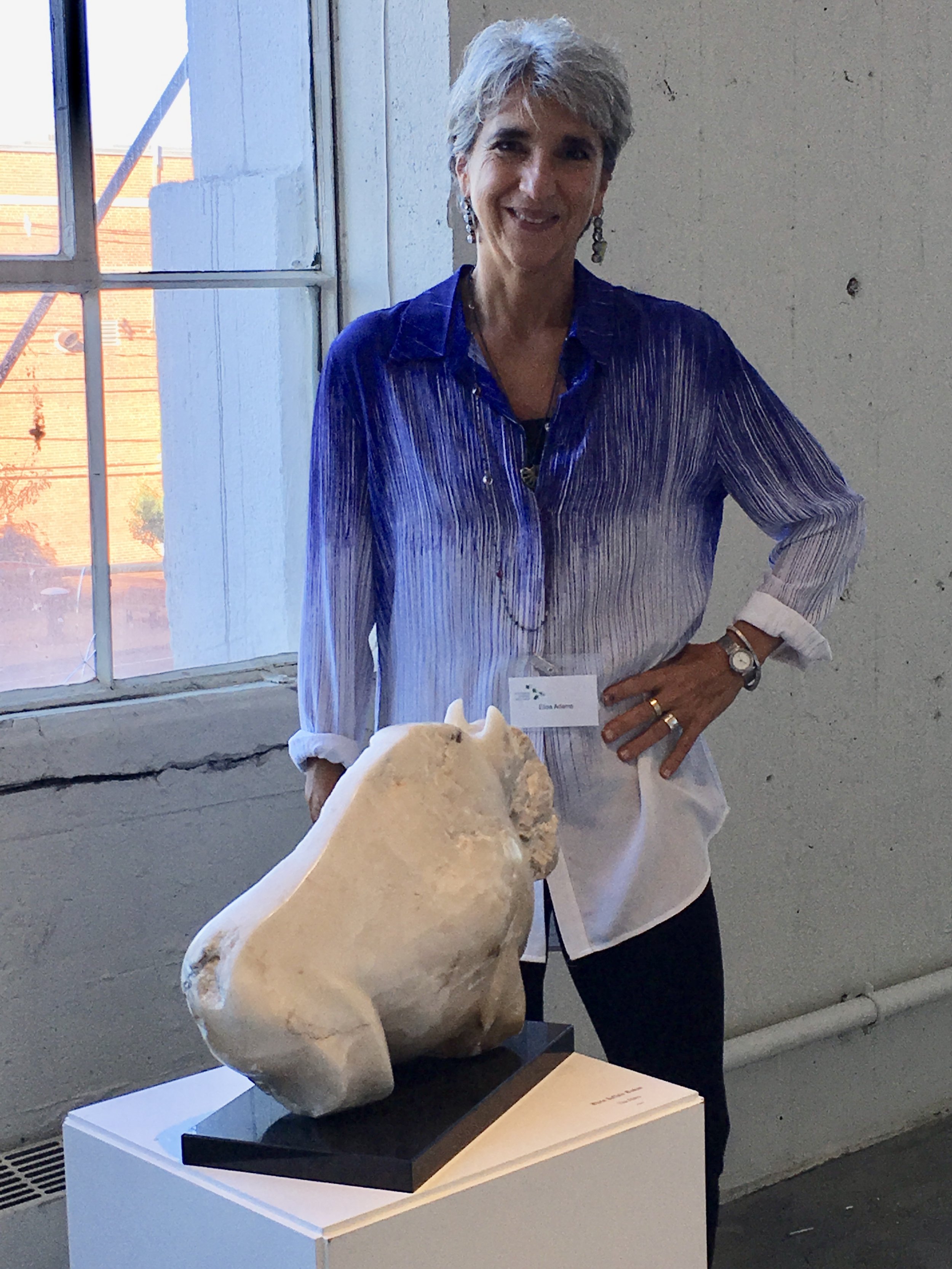ARTS & ENTERTAINMENT
Elisa Adams: A Life’s Work, From Heart to Hands
by Euletha Dukes
“From that one little class I took all those years ago, look what it’s turned into,” sculptor Elisa Adams says with a smile, reflecting on the first sculpture she made twenty years ago. “I surprised myself by how much I loved it, and I decided to just keep trying to make more of it.” We’re glad she did, because now some twenty years later, when we look at Elisa’s creations, we see nothing less than masterful.
Elisa Adams is an award-winning sculptor who has shown at more than 100 national and international shows, and her work is in private collections as far as Germany, Switzerland, and China. As a chiropractor by day—a work of healing—she channels this same healing expression through sculpture.
While looking at sculpture, viewers might initially see the obvious—the texture, shapes, and colors, but it doesn’t take long before the emotions are pulled in, evoking calm and peace. For a medium that is time-intensive and physically demanding, these delicate pieces of art reflect forethought, emotion, and patience poured into hard stone, yet appear to be soft. Each sculpture that Adams creates is a form of self-expression. She says, “I feel an emotion when I’m making each piece, and I want people to feel that too.”
Since no two stones are exactly alike, Adams’ creative process begins with the stones she carefully selects at the warehouse in New York. She prefers to buy her materials in person so she can see and feel them. While Adams looks at color, size, and shape to start, she also wants to see which stones speak to her enough to want to work with them.
Stone selection is almost an art in and of itself. Different regions across the country and around the world boast their own unique varieties, so there are hundreds of materials to choose from. Adams typically works with alabaster, soapstone, and marble, but she also enjoys working with other lesser-known materials, such as African Wonderstone. Adams has a knack for selecting materials embedded with stunning natural elements that delight the eye. The eye-catching piece Laughing Bodhisattva is a perfect example. Made of green soapstone from Iran, its shimmering opalescence with beautiful striations woven throughout draws viewers in and exudes a sense of joy and laughter.
As Adams works on a piece, she moves through it organically, letting her ideas take shape as she goes along. She says that working with stone feels investigative, as if engaged in a sensory conversation. Each creation is thus quietly introspective and expressive.
As Adams describes her work, you can catch a glimmer of those conversational moments in her studio, her hands and arms in sweeping gestures as if standing in front of an imaginary piece of stone. “Maybe I can open it up over here?... or what about that curve right there? … I get completely lost in time when I’m working,” she says. “You could think that 5 minutes passed but when I look up it’s 4 hours later.”
Adams has always been one for taking on a challenge and pushing the medium to its limits. With sculpture, it’s the challenge of making a hard material look soft. “I like taking a stone that’s hard and square, and challenging it to be as thin as I can make it, even at the risk of it breaking in the process,” she says. But she also sees beauty in imperfection. “Even if a piece falls off when I’m making it, it might end up better than how I thought it would anyway! So it’s both a challenge and a learning curve.”
Luminosity by Elisa Adams
Soapstone, for example, is soft and easier to work with, but it’s that same quality that makes it prone to easily breaking. The piece called Luminosity, an octopus carved from alabaster the color of a fiery orange sunset, was a challenge to create because of the natural mud veins that course throughout the stone, making it sensitive to breaking. Over time, Adams has developed a feel, literally, for a variety of stones—some require more energy and power to make even the smallest dent, while others need only a gentle touch.
As a viewer, it might be surprising to learn just how sensory carving stone really is. Besides sight and touch, the art of sculpture also involves sound and smell. Some varieties “sing” while she is filing them down, giving her clues to how close she is filing to the edge, or she can “hear” how thick or thin it is. Each stone also has its own unique scent. Recruiting the senses while creating a piece of art that uses natural materials is a testimony to our relationship with the earth and environment that it came from.
Once a piece is finished, Adams mentions one more consideration that viewers might overlook: the mount. Adams points out that the work doesn’t end with smoothing or making a sculpture shine. There is also the question of orientation—from selecting the base to deciding how to place it are equally important steps in finalizing the work.
Adams most recent project is inspired by her fascination with tarot cards. She is currently working on creating sculptures of the 22 major arcana characters in a tarot deck. “To me they reflect more where you are in life, not so much as a divining tool.” So far, she has made 11 sculptures for this project, and is expanding her skills to incorporate other mediums, such as ceramic, fiber art, felting, quilting, wire, and glass.
Over the years, Adams has participated in numerous art fairs, including showings at the Art Expo NY, The Palm Beach Show, and was at Art Basel week in Miami. She credits these events with the validating nature of community and the inspiration to further her craft. Adams says that these events are worth applying to despite the unknowns. She recalls the time she applied to the prestigious Chicago SOFA Art Fair, and was surprised that she got in. “The organizer told me he gets 75 to 100 requests a day to show. A day. And you are here. It was incredibly affirming.”
It is validating moments like these, as well as the generous spirit of fellow artists, that inspire her to not only keep going, but to show the same encouragement for others interested in learning the craft. “For me it’s all about the people and connecting. This is one conduit that gets me to talk to all these people, and they’ve been so joyous and willing to share their knowledge. For me, community is where it’s at.”
“For me it’s all about the people and connecting. This is one conduit that gets me to talk to all these people, and they’ve been so joyous and willing to share their knowledge. For me, community is where it’s at.”
It’s fitting, then, that one of her most rewarding commissions to date would be a community-based one. Adams created sixteen fossil-themed pieces for The Wishing Stone Garden at Boston Children’s Hospital. A project 9 years in the making, it was installed in June 2023 and is open to the public. Each sculpture is thoughtfully placed in the garden for patients to roam around and find. It’s a place that conveys a sense of peace and calm for visitors, especially in times of stress, negativity, or after receiving bad news.
“This sums up why I do my art, and the Children’s Hospital was the epitome of that. If I could bring a moment of joy to a child who is suffering, that’s the best part.”
“This sums up why I do my art,” she says, “and the Children’s Hospital was the epitome of that. If I could bring a moment of joy to a child who is suffering, that’s the best part.”
Adams served four years as the President of New England Sculptors Association (NESA), and she brings this sense of community to inspire others to not only join in the fun as beginning or seasoned sculptors, but to break down barriers in people’s minds about sculpture as an art form. People buy paintings because they know what to do with it, but what do you do with a sculpture? NESA is driven to educate people about the variety of sculptures out there that they themselves can own.
During COVID when the world was on pause, NESA put the time to good use by revamping a lot of their behind-the-scenes work. They now have new bylaws, a new website, and have increased efforts to make sculpture more visible and accessible in public spaces. Some successful examples include the Winchester Riverwalk, and soon at a space in the Mattatock Museum in Waterbury, Connecticut. Adams has also seen NESA’s membership grow tremendously over the years due to these intentional, community-based efforts.
Now that things have opened up post-COVID, Adams would love to see NESA help implement more community-based activities. “We want to think big!” she says. There are so many opportunities for members to reach the community, such as teaching kids how to incorporate sculpture in their lives and have fun.
Elisa Adams in front of one of her sculptures.
Sculpture has brought joy and balance to Adams’ life, both personally and within the community. In a word, it has been rewarding. An exchange happens when viewers are drawn in to appreciate Adams’ work. Emotions such as joy, calm, and peace are more present. Speaking to the power of creating and sharing her work, Adams says, “It’s a heart-opening experience.” For us viewers, the feeling is mutual.
Currently, Elisa Adam’s work can be seen at Three Stones Gallery in Concord, Mass., Gallery Sitka in Newport, R.I., and a permanent installation of The Wishing Stone Garden is open to the public at Boston Children’s Hospital at 300 Longwood Avenue.




